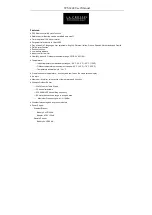
1.3.2 Thermo Sensor Unit (Transmitter)
D1: Outdoor Temperature D2: Transmission Indication LED
D3: Temperature Probe D4: “
°
C/
°
F” button
D5: Channel Selecting Switch D6: “TX” button
D7: Wall Mount Hole D8: Battery Door
1.4. Getting started
•
Open the battery compartment of display unit and transmitter and place both
instruments on a desk with a distance of approximately 1.5 meter. Check that no
other electronic devices are close. Insert the batteries first into the battery
compartment of the display unit and immediately afterwards the batteries of the
transmitter, observing the correct polarity.
•
The weather symbol indicator (A1) starts flashing. Using the buttons “+” (B5) and
“-“ (B7) you can set the actual weather of your place. The weather symbol can be
set later, without inserting the batteries again (see 1.5.4 Weather symbol setting).
•
The display unit automatically starts scanning the RF 433MHz signal to register
the Thermo Sensor Unit after batteries are inserted. If the reception of outdoor
temperature fails, check the batteries and try it again. Check if there is any source
of interference. Manual initialization can be helpful (see 1.5.7 transmitter). The
attached transmitter is preset to channel 1. Using channel switch (D5), you can
choose another channel as well.
•
After scanning the Thermo Sensor Unit the clock will then scan the DCF (radio




























